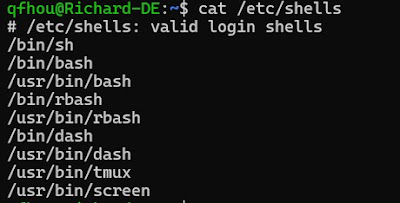Introduction to Shell Script on UNIX (1)
Shell解析器
可以通过以下命令查看系统所提供的解析器
$cat /etc/shells
HelloWorld example (helloworld.sh)
创建脚本程序
$touch helloworld.sh
$vi helloworld.sh
Edit:
#!/bin/bash
echo "helloworld"
or $cat > helloworld.sh
#!/bin/bash
echo "HelloWorld!"
Note:
First line: #!/bin/bash
Exit cat > by ctrl + c
脚本的执行方式
1 bash/sh + 脚本的相对路径/绝对路径
sh
$sh ./helloworld.sh
$sh /home/qfhou/bash_study/helloworld.sh
Similarly for bash
$bash ./helloworld.sh
$bash /home/qfhou/bash_study/helloworld.sh
2 采用输入脚本的相对路径/绝对路径执行脚本 (脚本需要具有可执行权限)赋予helloworld.sh可执行权限
$chmod +x ./bash_study/helloworld.sh
Note:
Search cmd history
ctrl + r + string
(reverse-i-search)`ch': chmod +x ./bash_study/helloworld.sh
Full history
$history
执行脚本
$./helloworld.sh
$/home/qfhou/bash_study/helloworld.sh
变量
定义
$变量名=变量值 (=前后不能有空格)
显示变量值
$echo $变量名
撤销变量
$unset 变量名 (not unset $变量名)
静态变量声明(不能撤销)
$readonly B=9
把变量提升为全局环境变量,可供其他 Shell 程序使用
$export 变量名
特殊变量
$n
功能描述:n 为数字,$0 代表该脚本名称,$1-$9 代表第一到第九个参数,十以
上的参数,十以上的参数需要用大括号包含,如${10}
$#
功能描述:获取所有输入参数个数,常用于循环 , 判断参数的个数是否正确以及
加强脚本的健壮性
parameter.sh
Results
$*
(功能描述:这个变量代表命令行中所有的参数,$*把所有的参数看成一个整体)
$@
(功能描述:这个变量也代表命令行中所有的参数,不过$@把每个参数区分对待)
Test (parameter.sh)
$?
(功能描述:最后一次执行的命令的返回状态。如果这个变量的值为 0,证明上一
个命令正确执行;如果这个变量的值为非 0(具体是哪个数,由命令自己来决定),则证明
上一个命令执行不正确了。)
Note: True -> 0; False -> 1
Last execution:














